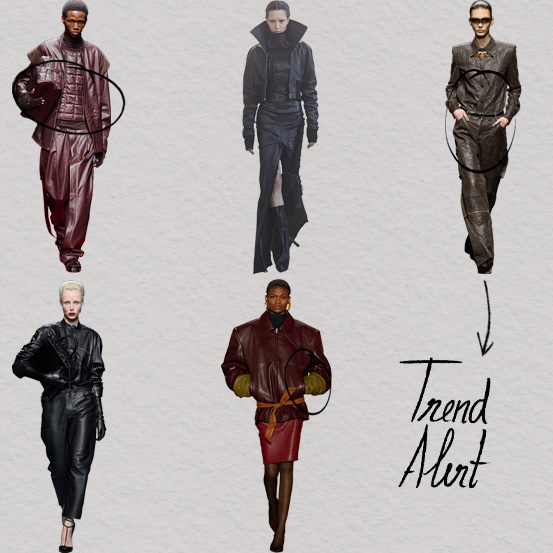The Big Book of Trends
From window shopping to screen shopping: tempered glass screens have joined the transparent glass of street shop windows in the contemporary consumption equation, but have they replaced them? In an era that has brought a multitude of channels for checkout, what fashion consumption habits has 2024 brought - and where are they headed?
When I was a teenager, I used to ask my mom for this birthday present: a trip to the shops. Not a specific item of clothing or a specific brand, but an afternoon of her time - she, my mother, with her opinion and financial resources - to do some market research on a street of shop windows and, consequently, collect a small selection of items that would be said birthday present, curated according to my wishes and validated by my mother's taste. It was the 90s and that was how you did the “add to cart” thing. Today, the process is not exactly the same. Years ago - decades ago - the online world changed the game, allowing this journey of discovery to be done first in cyberspace and only later, eventually, in brick-and-mortar. Although there is a playful side that remains in this romantic (and old school?) idea of going to the shops, it is the result of a desire and not an obvious need. According to Intergrowth.com, a platform dedicated to growing businesses, 63% of all purchases start online, even if the actual checkout takes place in a physical store. No wonder: today's digital world is no longer just a rudimentary HTML e-shop that takes hours to open. Browsing the web is just a tiny part of the consumer experience in the 21st century and in 2024 in particular, considering that today's world is advancing at breakneck speeds in terms of new and unprecedented, stimulating and personalized offers with the help of Artificial Intelligence, in addition to the boom in apps and social networks, which have allowed easy, fast and indiscriminate access to the web (of stores, influencers, products, reviews) via mobile, right in the palm of your hand.
This is where the new generations are mainly dictating the latest consumer habits. According to Scayle.com, a platform that offers solutions for commercial growth, AI is one of the main trends of this new era and the one that is generating the most transformations - in step with its controversy -, among the public and in the retail sector, with no exception for the Fashion industry. Although it can divide opinions, it also has a strong impact on the way a business is created, generated and managed. Whether in terms of design and personalization, improving the consumer experience or optimizing the production chain, all stages of the commercial process can benefit from the addition of artificial intelligence, says the platform. According to McKinsey, renowned for its work in the area of performance (as well as for the consequent recognized research and reports on the matter), artificial intelligence is expected to increase the profits of the fashion industry between 150 and 275 billion dollars in the next three to five years, with the additional hope that it can improve challenges such as inclusion and business sustainability, while also boosting creativity across the spectrum of the segment (it remains to be seen whether, in addition to solving the difficulties, it will not create new problems). This popularity of AI and its influence on consumers, in particular, more than on the fashion business, is linked to its ability to predict trends and personalize the shopping experience: with the collection of increasingly precise data and information about each customer, and the growing ability to transform this into knowledge that encourages excellent curation by brands (such as customized shopping models, personal recommendations and marketing messages tailored to each recipient), the premonitory analysis of Artificial Intelligence will increasingly play a leading role in defining common trends in consumer groups, in the way in which brands can best relate to each of their followers and how they can make content available in a way that makes sense. Everything indicates that, in a virtual world full of labels, the “store” experience, i.e. e-shop, is the priority over the product itself: talking to the customer seals the deal.
Perhaps this is why social networks such as Instagram and TikTok have also become a modern-day shopping center, with more impact than online stores, since they offer a tailor-made experience for their users, moving through their followers' favorite channels and using the identification factor through the influencers that their target audiences love. According to Scayle, social commerce is one of the consumer trends of 2024 that is here to stay (the speed of the modern world will dictate for how long), by allowing consumers to purchase goods and services through their favorite social media apps. This practice is not new in some parts of Asia, where concepts such as live shopping (that is, buying through a livestream on social media) have become very popular. And by popular, we mean this: the total revenue forecast from live shopping streams in China is around 700 billion dollars, says a study for 2023. (Still) This is not the reality in the Western world, where this trend has enjoyed more of a soft opening, though live shopping is growing rapidly, in step with social networks as the preferred destination for a good retail therapy. The reason for their popularity is not hard to see: for many millennials and Gen Z, who grew up under the aegis of digital, Instagram and TikTok have become not only their search engines (according to Emarketer, Gen Z uses Google for searches 25% less than Gen X, aka Baby Boomers, and almost half of Gen Zs prefer social media to search engines, with 44% discovering new brands on social media on a daily basis), but also their virtual shopping malls, notably with the emergence of features such as the possibility of product tagging in images - a functionality that this generation is more than used to -, but also the live shopping that TikTok launched relatively recently. In fact, statistics indicate that live commerce, by 2026, could account for around 10% to 20% of all e-commerce sales. In a way, see now, buy now, introduced just under a decade ago at fashion shows as a way to buy a selection of pieces right after the show, takes on even bigger and more literal proportions in 2024.
Part of this success also has to do with privileged access to the target audience, who selected which channels to follow in order to be impacted in the best way with the products they are looking for and the brands that fit with their fashion and lifestyle imagination. Once again, it has to do (also) with personalization, specificity, something that also argues in favor of the success of exclusivity programs, such as membership programs, which, although not new, allow for a more individualized connection with each consumer. More or less consciously, this option opens space for the customer to feel that there is an intimate and exclusive connection with a certain industry player and emulates a sense of belonging to a select community. It is therefore not surprising that 32% of customers value exclusive added value and 28% value personalized offers as some of the most appealing features of a subscription program of this kind. These nuances also mean that consumers are always being challenged with new products that are “just for them” and are therefore constantly stimulated - which is also a trend in modern consumerism: in a world where distractions multiply, whoever captures attention wins, so customers prefer brands that know how to communicate and foster engagement through the curation made possible by new technologies combined with creativity.
Part of this creativity and curation also involves understanding market trends and customer concerns, and one of its buzzwords - which is not new - is sustainability. Recommerce, that is, the sale of second-hand or dead stock goods, has been gathering popularity as a response to the problem of waste, particularly in large fast fashion chains (but not only). Categories such as pre-owned, pre-loved or archive have emerged to promote the idea of recycling and reuse and to deny the disposability of textiles, a current concern that is at the forefront of the general population's mind - and which includes the section that has decision-making power on par with purchasing power. The vintage theme and the applications designed to promote its sale are growing rapidly, which also supports the rise of this new term: recommerce is now a fundamental focus for retailers in Europe and North America because it solves two of their biggest problems - the intense pressure on sustainability in the clothing market in general, by allowing them to reduce waste; and the management of returns, with the consequent impact they have on sales, as they are one of the biggest loss-making aspects that a brand needs to overcome. In this sense, there has also been a change in the way brands approach returns, with some shortening the return period for an item to seven days, for example, instead of the standard 30. The process is designed to recover the item while it is still in a saleable condition, before it reaches a reduction and discount rate, acting with the purpose of protecting margins.
It’s safe to say that the rise of e-commerce and social commerce will continue to rule retail in 2024, with the nuances of personalization and communicating to your audience taking centre stage in how consumers choose which players to invest in – a personalized and engaging digital shopping experience seals the deal. Of course, we didn’t get here simply because of ever-accelerating technological advancement: the 2020 pandemic forced brands to look to digital in the wake of the temporary (or, sadly, permanent) closure of their physical locations, and the embrace of these online possibilities was precipitated by necessity, rather than a possible evolution with enough time to mature. Will this mean the imminent death of high street stores, then? Far from it. If 2023 has proven anything, it’s that ‘analogue’ still has a life ahead of it. One of the major post-Covid19 trends has been a return to roots and the offline life: as we spend most of our daily lives glued to screens, consumers have shown an increasing desire to buy in physical stores - it is no wonder that the aforementioned digital purchase statistics indicate that business can be closed offline. The added value of the physical store actually comes in the wake of this search for personalization that, curiously enough, fosters digital growth. Brick-and-mortar stores continue to enjoy the advantage of the expanded sensory dimension that only the real outside of the digital allows: with the opportunity to interact directly with products and store salespeople, away from the partition of tempered glass with blue light, but not completely disconnected from it, many consumers research products or services online before heading to the physical store. And when they get there, they are ready to buy. Also, 31% of customers are ready to immediately buy an item they discover in a physical store, because the visual appeal in person is more persuasive than in digital, as Emarketer.com assures. This means that it is increasingly important for brands to have an omnipresence, knowing how to articulate digital and physical, as one has not cannibalized the other, they are complementary. Creating a perfect synergy between the two entities is essential to respond to the demands of today's consumer, even if it is through practices as simple as Click & Collect - buy online, collect in person -, or features such as in-store returns for purchases made in e-shops. In other words, it can be said that modern consumer habits have not changed, exactly, but rather transformed, or rather, multiplied and made access easier, allowing people to see, desire, and impact from the distance of a double tap on a screen. But they have not killed off traditional consumption and its shop windows; high street retail is not that fragile after all, nor has it fallen into disuse. Because there are things that cookies and AI can try, but cannot replicate: human interaction. The senses, namely physical touch and tactility, continue to have a power that touchscreens do not.
Translated from the original in Vogue Portugal's The Big Book of Trends, published September 2024. Full stories and credits in the print issue.
Most popular


Relacionados

.jpg)






